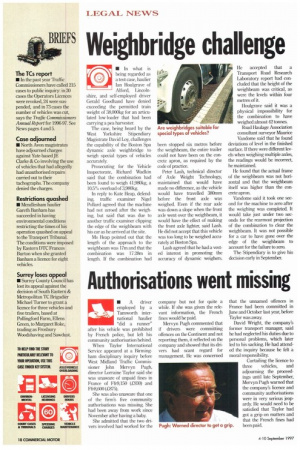Weighbridge challenge
Page 20

If you've noticed an error in this article please click here to report it so we can fix it.
• In what is being regarded as a test case, haulier Ian Houlgrave of Alford, Lincolnshire, and self-employed driver Gerald Goodhand have denied exceeding the permitted train weight of 38,000kg for an articulated low-loader that had been carrying a pea harvester.
The case, being heard by the West Yorkshire Stipendiary Magistrate David Loy, challenges the capability of the Boston Spa dynamic axle weighbridge to weigh special types of vehicles accurately.
Prosecuting for the Vehicle Inspectorate, Richard Wadkin said that the combination had been found to weigh 41,980kg, a 10.5% overload of 3,980kg.
In reply to Kate Heap, defending, traffic examiner Nigel Pollard agreed that the machine had not zeroed after the weighing, but said that was due to another traffic examiner clipping the edge of the weighbeam with his car as he arrived at the site.
Ms Heap pointed out that the length of the approach to the weighbeam was 17m and that the combination was 17.28m in length. If the combination had been stopped six metres before the weighbeam, the entire trailer could not have been on the concrete apron, as requited by the code of practice.
Peter Lash, technical director of Axle Weight Technology, maintained that would have made no difference, as the vehicle would have travelled 380mm before the front axle was weighed. Even if the rear axle was down a slope when the front axle went over the weighbeam, it would have the effect of making the front axle lighter, said Lash. He did not accept that this vehicle was too long to be weighed accurately at Boston Spa.
Lash agreed that he had a vested interest in promoting the accuracy of dynamic weighers. Ile accepted that a Transport Road Research Laboratory report had concluded that the height of the weighbeam was critical, as were the levels within four metres of it.
Houlgrave said it was a physical impossibility for the combination to have weighed almost 42 tonnes.
Road Haulage Association consultant surveyor Maurice Vandome said that he found deviations of level in the finished surface. If there were different levels when weighing multiple axles, the readings would be incorrect, he maintained.
He found that the actual frame of the weighbeam was not horizontal and that the weighbeam itself was higher than the concrete apron.
Vandome said it took one second for the machine to WM after the weighing was completed. It would take just under two seconds for the rearmost projection of the combination to clear the weighbeam. It was not possible for a car to have gone over the edge of the weighbeam to account for the failure to zero.
The Stipendiary is to give his decision early in September.








































































































